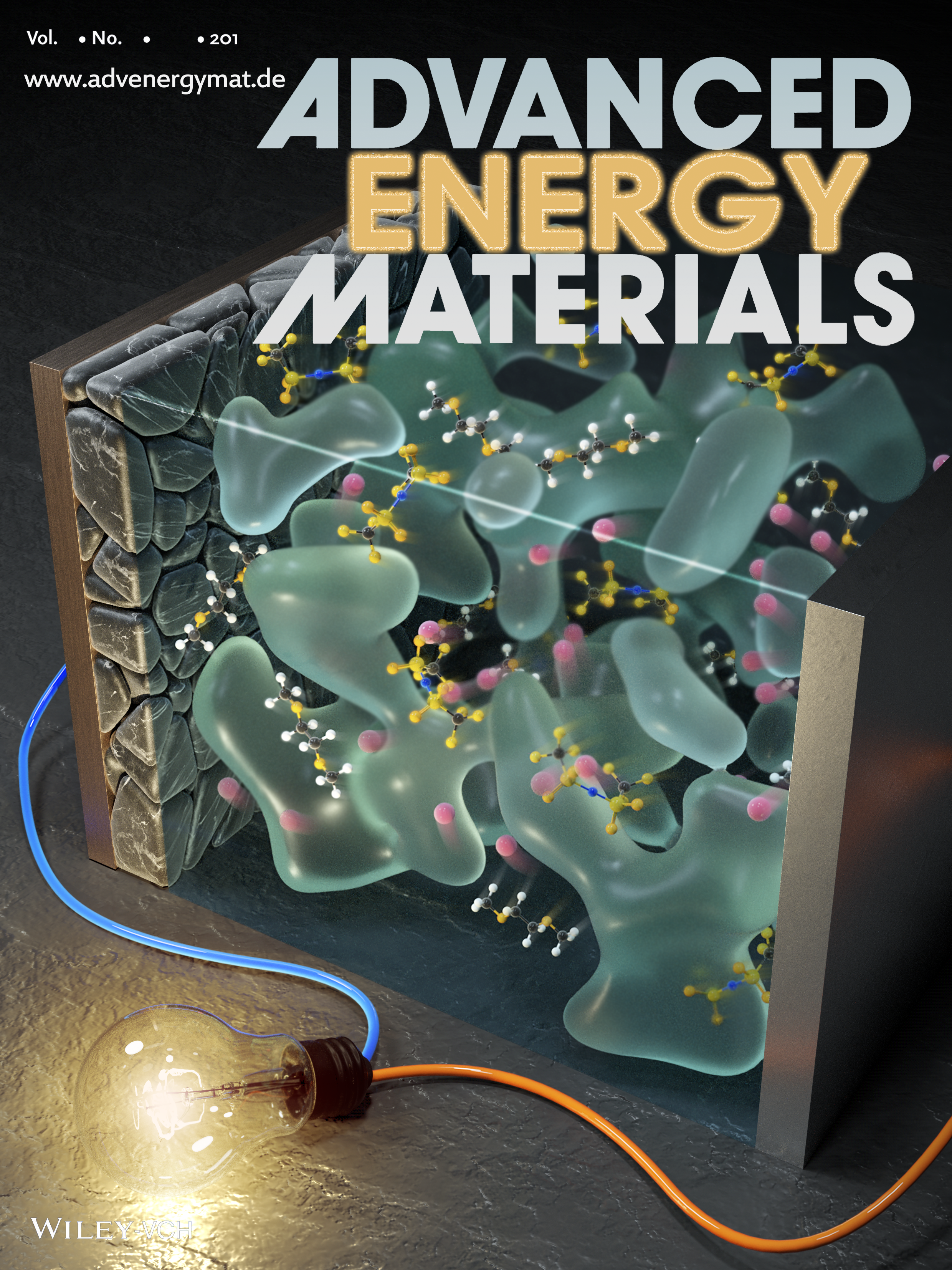Synergistic Effects on Lithium Metal Batteries by Preferential Ionic Interactions in Concentrated Bisalt Electrolytes
| author | Kyungwon Kwak |
|---|---|
| journal | Advanced Energy Materials |
Lithium metal batteries (LMBs) have the potential to deliver a greater specific capacity than any commercially used lithium battery. However, excessive dendrite growth and low Coulombic efficiencies (CEs) are major hurdles preventing the commercialization of LMBs. In this study, two different salts, lithium difluorophosphate (LiDFP) and lithium bis(trifluoromethanesulfonyl) imide (LiTFSI), are chosen for use in concentrated electrolytic systems. By mixing salts with vastly different cation–anion interaction energies, the ion solvation structures in the electrolyte can be modulated to enhance the physical/electrochemical properties and suppress Li dendrite growth in LMBs. Among the investigated electrolyte systems, 2.2 m LiDFP + 1.23 m LiTFSI in 1,2-dimethoxyethane is proposed as a highly promising electrolyte system because of its high conductivity (6.57 mS cm−1), CE (98.3%), and the formation of an extremely stable solid–electrolyte interface layer. The bisalt electrolyte presented herein, as well as the associated concepts, provide a new avenue toward commercial LMBs.

(https://doi.org/10.1002/aenm.202003520)

Jeon So-yeon (first author, doctoral student)
Articles
-
 Synergistic Effects on Lithium Metal Batteries by Preferential Ionic Interactions...
Synergistic Effects on Lithium Metal Batteries by Preferential Ionic Interactions...
-
 Operando Raman and UV-Vis spectroscopic investigation of the coloring and bleachi...
Operando Raman and UV-Vis spectroscopic investigation of the coloring and bleachi...
-
 Ultrafast intraband Auger process in self-doped colloidal quantum dots
Ultrafast intraband Auger process in self-doped colloidal quantum dots
-
 Two-dimensional electronic spectroscopy of bacteriochlorophyll a with synchronize...
Two-dimensional electronic spectroscopy of bacteriochlorophyll a with synchronize...
-
 Superexchange Coupling-Induced Enhancements of Thermoelectric Performance in Satu...
Superexchange Coupling-Induced Enhancements of Thermoelectric Performance in Satu...
-
 Fluorescent Diagnostic Probes in Neurodegenerative Diseases
Fluorescent Diagnostic Probes in Neurodegenerative Diseases
- An Ethacrynic Acid-Brominaed BODIPY Photosensitizer (EA-BPS) Construct Enhances t...
-
 High Ammonia Uptake of a Metal-Organic Framework Adsorbent in a Wide Pressure Range
High Ammonia Uptake of a Metal-Organic Framework Adsorbent in a Wide Pressure Range
-
 Emerging Porous Materials and their Composites for NH3 Gas Removal
Emerging Porous Materials and their Composites for NH3 Gas Removal
-
 Light-directed trapping of metastable intermediates in a self-assembly process
Light-directed trapping of metastable intermediates in a self-assembly process
-
 Multiply Charged Conjugated Polyelectrolytes as a Multifunctional Inerlayer for E...
Multiply Charged Conjugated Polyelectrolytes as a Multifunctional Inerlayer for E...
-
 Green-, Red-, and Near-Infrared-Emitting Polymer Dot Probes for Simultaneous Mult...
Green-, Red-, and Near-Infrared-Emitting Polymer Dot Probes for Simultaneous Mult...
-
 Intermetallic PtCu Nanoframes as Efficient Oxygen Reduction Electrocatalysts
Intermetallic PtCu Nanoframes as Efficient Oxygen Reduction Electrocatalysts
-
 Pt Dopant: Controlling the IR Oxidation States toward Efficient and Durable Oxyge...
Pt Dopant: Controlling the IR Oxidation States toward Efficient and Durable Oxyge...
-
 Color-Runable Boron-Based Emitters Exhibiting Aggregation-Induced Emission and Th...
Color-Runable Boron-Based Emitters Exhibiting Aggregation-Induced Emission and Th...
-
 Catalytic Nanoframes and Beyond
Catalytic Nanoframes and Beyond
-
 Highly Crystalline Hollow Toroidal Copper Phosphosulfide via Anion Exchange: A Ve...
Highly Crystalline Hollow Toroidal Copper Phosphosulfide via Anion Exchange: A Ve...
-
 Molecular Design of Highly Efficient Heavy-Atom-Free Triplet BODIPY Derivatives f...
Molecular Design of Highly Efficient Heavy-Atom-Free Triplet BODIPY Derivatives f...
-
 Transformation of Colloidal Quantum Dot: From Intraband Transition to Localized S...
Transformation of Colloidal Quantum Dot: From Intraband Transition to Localized S...
-
 Mitochondrial Relocation of a Common Synthetic Antibiotic: A Non-genotoxic Approa...
Mitochondrial Relocation of a Common Synthetic Antibiotic: A Non-genotoxic Approa...
Designed by sketchbooks.co.kr / sketchbook5 board skin